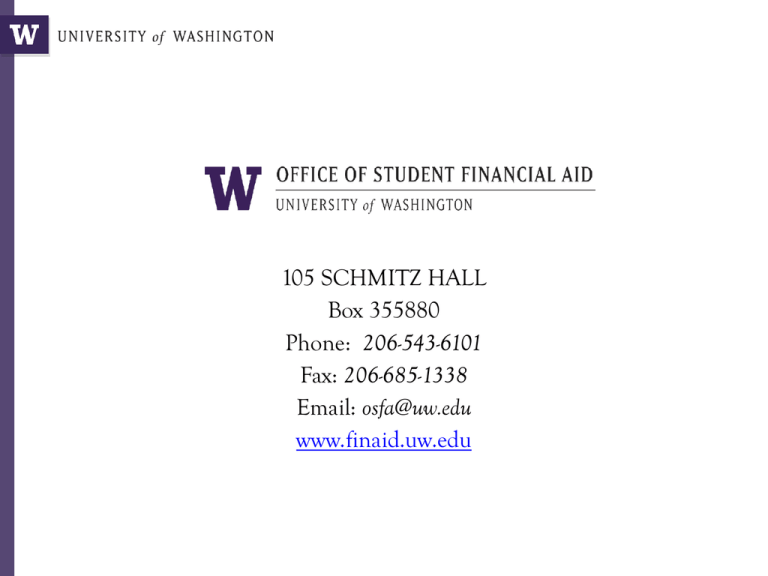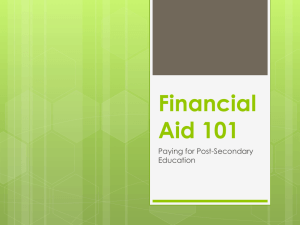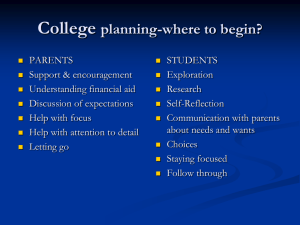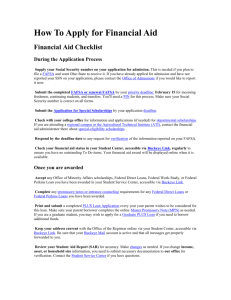Financial Aid Processes by UW Financial Aid Experts
advertisement

105 SCHMITZ HALL Box 355880 Phone: 206-543-6101 Fax: 206-685-1338 Email: osfa@uw.edu www.finaid.uw.edu 2014-2015 What you need to know about Financial Aid • • • • • • What is financial aid? Cost of attendance (COA) Expected Family Contribution (EFC) What is financial need Categories, types, and sources of financial aid Applying for financial aid - Free Application for Federal Student Aid (FAFSA) • Special circumstances • Release of Information What is Financial Aid? Financial aid is funding provided to students and families to help pay for postsecondary educational expenses General Eligibility Requirements • Must be enrolled/accepted in an eligible program of study • Must be pursuing a degree, certificate, or other recognized credential • Must be a U.S. citizen or eligible non-citizen • Must be registered with Selective Service (if male) over age 18 • Must have a valid Social Security Number What is Cost of attendance (COA)? • Direct costs • Indirect costs • Direct and indirect costs combined into cost of attendance • Varies widely from college to college The Cost of Attendance (per year – 2014/2015) • • • • Community College 4 Year Public 4 Year Private Trade/Career $17,828 $27,164 $49,604 (varies) Costs are estimates based on resident status, full time enrollment, not living with family. What’s included: tuition, books, room & board, transportation, and personal expenses. What is the Expected Family Contribution (EFC)? • Amount family can reasonably be expected to contribute • Stays the same regardless of college • Two components -Parent contribution -Student contribution • Calculated using data from a federal application form and a federal formula What is Financial Need? Cost of Attendance -Estimated Family Contribution Financial Need Direct Cost: Tuition, Housing (depending on school), Misc. student fees Indirect Cost: Books/Supplies, Personal, and Transportation Categories of Financial Aid • Need based • Non-need based Types of Financial Aid (Sources of Money - Federal, State, and Institutional Money Awarded to Students Based on Financial Need) • Grants • Work Study • Loans • Scholarships Grants (Money that does not have to be paid back; usually awarded on the basis of financial need) • Federal Grants - PELL - SEOG • State Grants - State Need Grant (depends on state residency) • Institutional Grants - depends on school attending Work Study (or Student Employment) •Allows student to earn money to help pay educational costs (Work study is a financial aid program based on financial need – while student employment is not based on financial need. Check with school attending) Loans •Money students and parents borrow to help pay college expenses •Repayment usually begins after education is completed •Only borrow what is really needed •Look at loans as an investment in the future Stafford Loans • Student is the borrower • Interest rate 4.66% (July 1, 2014 – June 30, 2015) • Loan origination fee 1.072% (July 1, 2014 – Sept. 30, 2014) and 1.073% (October 1, 2014 – June 30, 2015) • Repayment begins 6 months after student drops below ½ time, leaves school or graduates • Deferment – a period in which repayment of the principal balance is postponed https://studentloans.gov • Sign promissory note online at https://studentloans.gov • Entrance counseling for first-time borrowers https://studentloans.gov Subsidized vs. Unsubsidized Stafford Loan • Subsidized Loan -Need based -Interest paid by government while student attending school ½ time or more • Unsubsidized Loan -Non-need based -Government does not pay interest -Students have option of paying interest while attending school or have it added to the principal Federal Perkins Loan • Eligible students -Undergraduate or graduate students -Priority to exceptional need • Interest rate: 5% • Nine-month grace period • Deferment and cancellation provisions available (check with your school) PLUS - Parent Loan for Undergraduate Students • Non-need based • Interest rate 7.21% (July 1, 2014 – June 30, 2015) • Loan origination fee 4.288% (July 1, 2014 – Sept. 30, 2014) and 4.292% (October 1, 2014 – June 30, 2015) • Repayment options: - Begins 60 days after the final loan disbursement for the period of enrollment for which you borrowed - Make interest payments and defer principal until after the student is no longer enrolled, with 6 month grace period • Complete PLUS Request Process at https://studentloans.gov, then credit check will occur • Funds electronically transferred to the student’s account unless parent indicates otherwise PLUS Denial • If the PLUS loan is denied (due to adverse credit) by the Loan Origination Center (LOC), the student may be eligible for additional Unsubsidized Stafford Loan -Additional amount will depend upon a student’s grade level and unmet cost of attendance Scholarships Begin process at least one academic year prior to need. Applications are generally requested 2-3 months before deadline. Why are they looking for funding – to pay tuition, travel or study abroad, or public service project? What kinds of sources are available: • Need-Based Scholarships • Merit-Based Scholarships • Local Scholarships • National Scholarships Scholarship Applications •Scholarships are self-search—check with HS Counselor, Library and college search services (www.fastweb.org or theWashBoard.org). •Don’t pay for scholarship searches! •Some schools also require scholarship applications. Scholarships Timeline: Plan ahead and meet with mentors during Summer and Autumn Quarters, keeping in mind that deadlines generally occur during Winter Quarter and interviews in the Spring. Free online scholarship resources • fastWeb www.fastweb.com • theWashBoard www.theWashBoard.org • College Board www.collegeboard.com • College NET www.collegenet.com/about/index.html Applying for Aid • All schools use the Free Application for Federal Student Aid (www.fafsa.ed.gov) • Some schools use the CSS Profile form (fee attached). • Some schools use their own forms. (**Please contact the Financial Aid Office at the schools of interest for additional information) FAFSA Application • May be filed at any time during an academic year, but no earlier than the January 1st prior to the academic year for which the student requests aid •For the 2015-2016 academic year, the FAFSA may be filed beginning January 1, 2015 •Please check with each individual school for FAFSA priority filing deadline dates •File online at: www.fafsa.ed.gov • If you and/or your parent do not know your PIN, you can get help at www.pin.ed.gov FAFSA on the Web Good reasons to file electronically: • Built-in edits to prevent costly errors • Skip logic allows student and/or parent to skip unnecessary questions • More timely submission of original application and any necessary corrections • More detailed instructions and “help” for common questions • Ability to check application status on-line • Simplified application process in the future IRS Data Retrieval Tool • While completing the FAFSA on-line, applicant may submit real-time request to IRS for tax data • IRS will authenticate taxpayer’s identity • If match found, IRS sends real-time results to applicant in new window • Applicant chooses whether or not to transfer data to FAFSA on-line • Available February 1, 2015 for 2015-16 processing cycle • Participation is voluntary and could reduce documents requested by a financial aid office What happens after you apply? • The federal processor will send the information electronically to the schools you specify on the FAFSA • Receive a Student Aid Report (SAR) • Review the SAR • Respond to any requests for additional information • Each college determines your eligibility • Each college will send an award letter/notice to you Award Process • Award letters for freshmen typically sent in February, March and April • Award letter will list type and amount of aid student will receive • Most likely a paper letter but could be electronic also • Award may be preliminary pending additional information • May need to sign and return to reserve award Comparing Award Letters • Each school offers the student an award letter— types and amounts of aid • Compare total cost (not just tuition) • Compare tuition • Compare borrowing level and project over 4 years • Ask if scholarship can be renewed. The Husky Promise (University of Washington) • Guarantees that full tuition will be covered by grant or scholarship support if you are a low or lower middle-income student. [Other colleges/universities may offer a similar program – please check individually] Husky Promise (continued) • Be a Washington State Resident. • Meet current eligibility criteria for either the Pell Grant or State Need Grant programs. • Submit the Free Application for Federal Student Aid (FAFSA) by the UW’s priority filing date of February 28 for the following academic year. • Enroll full-time. • Be pursuing a first bachelor’s degree. • Maintain satisfactory academic progress while at the University. Revisions to Eligibility •Cannot be reported on the FAFSA, but written explanations must be sent to each college/university •Financial Aid Offices can review changes in parent & student income • Financial Aid Offices can review unusual expenses for the student and parent • Unemployment, job layoffs, high medical expenses are typical but not the only adjustments we make Dependent Student • Under the age of 24—requires parents information unless married, or have your own children, or are a veteran or on active duty, or an orphan, or in graduate school. • Additional items may change dependency status: emancipated minor; legal guardianship; homeless; emergency shelter or transitional housing (please review FAFSA instructions). • If your parent is either single or widowed, answer the questions about that parent only Dependent Student (continued) • If your parent of record for the FAFSA has remarried, step-parent information is required for the application. • If your parents are divorced or separated, answer the questions about the parent you lived with more during the past 12 months. • What if you can’t get parent information? Tax Credits • The American Opportunity Tax Credit (up to $2,500 for four years) is available for all students attending at least part-time, with a head of household income of less than $90,000 or a married-filing jointly income of up to $180,000. As much as 40% ($1000) can be received as a refund. • The Lifetime Learning Credit (up to $2,000) is available for any student or parent paying qualified education expenses, but cannot be taken at the same time as the American Opportunity Tax Credit. There is no minimum enrollment requirement. • 1098-T forms list all tuition and related fees, scholarships, fellowships, and grants. Colleges/universities will have these documents available by the end of January. • Additional information on Tax Benefits for Education can be found at http://www.irs.gov/pub/irs-pdf/p970.pdf Release of Information • Remember, a student’s financial aid record and account is their private information. In accordance with U.S. privacy laws, University offices cannot give out information to parents or any 3rd party without the student’s written permission – even if they are paying tuition for the student. Please check with each school to find out their individual process. References Internal Revenue Service (2014, September 26). Publication 970: Tax benefits for education. Retrieved from http://www.irs.gov/pub/irs-pdf/p970.pdf. National Association of Student Financial Aid (2014, September 26). Financial Aid Night Presentation. Retrieved from http://www.nasfaa.org/counselors/Financial_Aid_Night_Presentation.aspx. University of Washington (2014). Office of Student Financial Aid.






